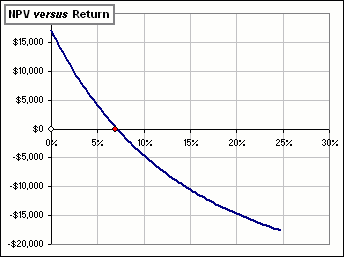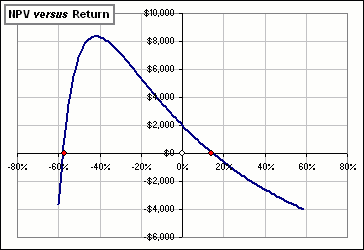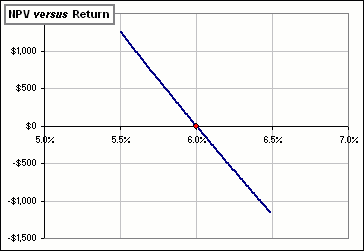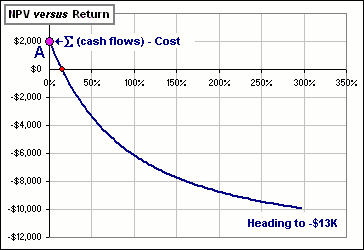| Net Present Value ... a continuation of multiple returns |
Suppose somebody said that, for a certain price, you could get the following cash flows:
- In a year, you pay $10K. We'll regard that as an outflow and count it negative: -$10K.
- A year later, you'd pay another $5K. That's a cash flow of -$5K.
- Then, in another year, you'd receive $17K. That's a positive cash flow of +$17K.
>I have no idea.
Okay, the present value of these cash flows, assuming some interest rate R, is:
-10000/(1+R) - 5000/(1+R)2 + 17000/(1+R)3.
Note: A term like 5000/(1+R)2 means 5000 is discounted for 2 years at the rate R.
Suppose you'd buy this scheme provided the return, R, was at least 6%.
Substitute R = 0.06 and get the present value:
-10000/(1.06) - 5000/(1.06)2 + 17000/(1.06)3 = $390.
>Yeah, so?
So you shouldn't pay more than $390.
>Suppose the guy selling me this scheme wanted $500?
Then you'd calculate: -10000/(1+R) - 5000/(1+R)2 + 17000/(1+R)3 - 500.
The first three terms give the present value of the cash flows. The last term is what you pay ... now.
Then, determine what return R will make this $0.
That is, the present value of the cash flows = the cost of buying the scheme.
That is:
-10000/(1+R) - 5000/(1+R)2 + 17000/(1+R)3 - 500 = 0.
It's 5.6% so ...
>So if I'm happy with that return, I'd pay the $500?
Why not?
In general:
| If the cash flows are A1, A2, ... AN which are made at future times
T1, T2, ... TN, and the cost of buying the scheme is P, then:
NPV = A1/(1+R)T1 + A2/(1+R)T2 + A3/(1+R)T3 + ... + AN/(1+R)TN - P is the Net Present Value. |
If the asking price, P, is too large then NPV will be negative. It's not a good scheme. Don't buy it.
>When was the last time somebody offered you such a crazy scheme?
Never, but here's another example:
| Suppose I could buy a company for $18K.
However, after the purchase, I'd have to pay $10K immediately, then another $5K a year later, but I'd receive $5K in profits every year after that ... for 10 years. Is it a good deal? >I'd solve that NPV = 0 equation to see what R is.
The graph of NPV would look like Figure 1.
>Sure.
|  Figure 1 |
It's much like the spreadsheet here.

You enter the cash flows in column A along with the Dates in column B.
You also enter the Cost and the current Date in cells E3 and E4, pick a range of returns then click a button to get a chart.
Note that column C has the discounting times ... in years.
The return is given in cell K1. If you're happy with that, buy the company.
If you're not happy, reduce the Cost in cell E3 and click again.
For example, instead of paying $11,900 reduce this to $11,00 and get a MUCH higher return.
Note that the first cash flow in cell A2 is the earliest. Indeed, since it's the same as the current Date in cell E4, this cash flow is immediate.
>So why don't you consider that first payout of $10K as part of the initial Cost of $11,900?
Yup, you could do that. Then you'd have this:

Mathematically speaking, it makes no difference.
However, it may be that you pay $11,900 for the company and immediately pay off the company's debt of $10K.
Anyway, you pay another $2K on Feb 8, 2005 and receive $15K on Mar 7, 2005 etc. etc. until Nov 19, 2005 when you will receive $7K.
>So, is it a good deal?
Huh? You asking me? I don't buy companies. I have a hard time buying a Big Mac and ...
| However, just as we saw in that "multiple returns" stuff, we can get multiple stuff here, too.
See Figure 2? >zzzZZZ The cash flows look like this:  |  Figure 2 |
>zzz ... Huh? Why would I choose that negative return? Couldn't I just assume that buying the cash flows for $3K would give me that positive return?
Sure. Let's assume it's Jan 1, 1995.
- That positive return is 14.7% so the first payment of $10K would, in 3 years
(from Jan 1, 1995 to Jan 1, 1998) be worth 10K*(1.147)3 = 15.1K.
(We'd count this as a loss of 15.1K.) - The second cash flow of $10K would, in 2 years, be worth 10K*(1.147)2 = 13.1K.
- The third cash flow of $10K would, in 1 year, be worth 10K*(1.147) = 11.5K.
- That last $5K, made 3 years from now, is worth $5K 3 years from now! (This is also a loss.)
- Together, that makes the cash flows worth: -15.1K + 13.1K + 11.5K - 5K = 4.5K, on Jan 1, 1998 (3 years from "now").
- Further, the initial payment of $3K will be worth 3K*(1.147)3 = 4.5K.
That means that the sequence of cash flows would provide the same return as investing your $3K at 14.7%.
>But what about that negative return?
Ah, yes. That's -58%.
The sum of the cash flow values (by Jan 1, 1998) is:
-$740 + $1761 + $4201 - $5000 = $222.
The value of your $3K investment would be 3000*(1-0.58)3 = $222.
>Huh? That initial $10K outlay would be worth only $740, in 3 years?
Yes. We calculate (1-0.58)3 = 0.074 and reduce 3-year cash flows by this factor.
>That doesn't make sense ... does it?
Then ignore negative returns, like that -58%. Indeed, ignore any returns where the slope of the NPV graph is positive.
In fact, I'd just take the largest positive return where the NPV graph has a negative slope.
>And if there aren't any of those?
Don't buy the cash flows. Instead, invest your money at some risk-free market rate ... like maybe 5%.
|
Note that this is much like buying a mortgage.
You pay, say $30K and receive $2615.54 every year for 20 years. What return are you getting? >I give up.
It's a 20-year, 6% mortgage. |  Figure 3 |
Consider again the example of Figure 2:
| Remember the magic NPV formula?
NPV = A1/(1+R)T1 + A2/(1+R)T2 + A3/(1+R)T3 + ... + AN/(1+R)TN - P For this example, we'd have:
For R = 0, NPV(0) = -10 +10 +10 - 5 - 3 = 2
... measured in kilobucks.
Now consider the values of NPV as R |  Figure 4 |
Note that, if the first cash flow has, as divisor, a power of (1+R) then NPV(+∞) is just - $P.
In our example, the first Cash Flow didn't have any divisor, so it's included in NPV(+∞) which is then: A1 - $P.
Moral?
If
- Sum of Cash Flows exceeds the Cost ... in our example, that's satisfied since: $5K > $3K
- Sum of the Cash Flows without discounting (at the R-rate) is less than the Cost ... in our example, that's satisfied since: -$10K < $3K
>And the graph will have a negative slope, eh?
It looks that way, don't it? 

 +∞
+∞